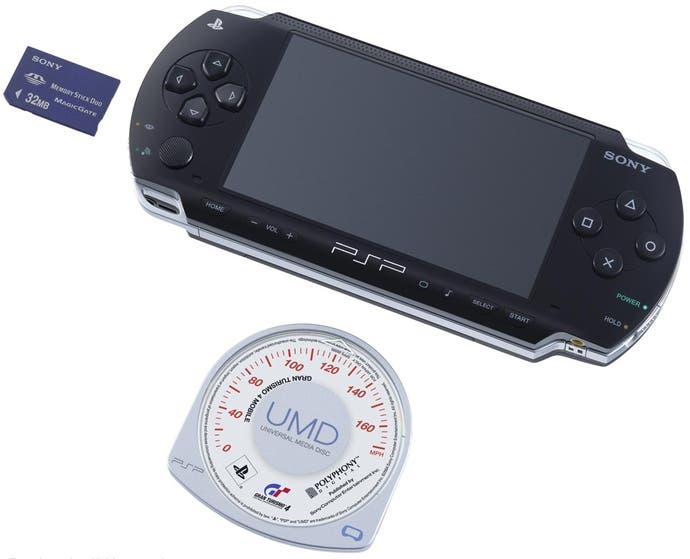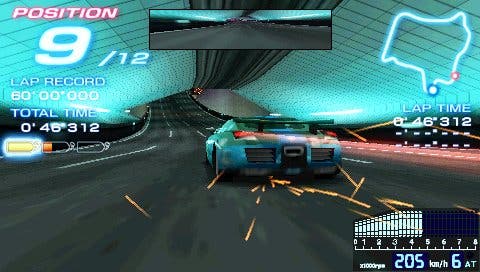PlayStation Portable
We go hands-on with Sony's first foray into handheld gaming.

This feature is brought to you courtesy of our good friends persistence and luck. Getting our mucky mitts on the enigmatic PSP has been a fraught process from day one; encased behind Perspex at E3 (and evidently linked to a bigger machine behind the scenes), and unavailable for a hands-on until we physically went and bought a vastly overpriced Japanese import yesterday, it's been hard work trying to tell the world what a PlayStation Portable is like to touch and feel. If you were into conspiracy theories, it wouldn't take a great deal of imagination to convince yourself that Sony didn't actually want anyone outside of Japan to be talking about its first step in the choppy waters of handheld gaming.
Many have come and gone in trying to take on the mighty Nintendo and all have fallen by the wayside: Sega, Atari, SNK to name but three of the more memorable casualties. Only now has Sony - the great pioneer of portable audio - felt the time is right to dip its not inconsiderable toes into this market, and many have been almost desperate to see it fail. Not least of all Nintendo, which seems to spend as much of its time taking pot shots at its rival than actually going about the business of keeping up the good work.
After all the sniping and negative publicity surrounding the PSP, it's something of a shock when you actually get it out of the packaging. A glossy, sleek scratch magnet of a device about six by three inches, by one inch deep, it's hardly what anyone would deem to be pocket sized. Dwarfing the likes of the already chunky N-Gage, and easily as heavy as the equally lumbering Nintendo DS (although much wider than the bulked out DS) it's a device that'll easily slip in an inside jacket pocket, but not an item you'd feel remotely comfortable about slipping in your jeans, unlike, say, the GBA SP. Not only would you have a job fitting it in there, you'd almost certainly risk scratching the screen beyond redemption, so the first thing you're going to want to do is buy some sort of carry case, because the PSP is one device you're definitely not going to want to scratch under any circumstances - and it doesn't even bear thinking about the mess you'll make if you drop it. Accidents will happen, as they always do, but the PSP is not going to fare too well next to its sensibly enclosed rivals. That bare exposed screen is asking for trouble.
Some have commented on the build quality of the PSP, and it's a slightly unfair accusation. The device feels perfectly robust in virtually all departments with a decent, comfortable D-pad and typically smooth symbol buttons placed exactly where you'd expect. The left and right shoulder buttons do admittedly feel somewhat cheap and a little loose for our liking, but it's hardly a deal breaker. The clincher for us (apart from the frankly enormous screen, which we'll come to in a moment) is the presence of the analogue nub - a tiny circular joystick in the bottom left corner that performs the exact same functions as the D-pad (and reportedly isn't actually a bona fide analogue stick in any case, although you'd be hard pressed to notice the difference). In the one game we've tested out on the PSP to date, the marvellous Ridge Racers, it feels so perfect it's hard to imagine it could be any better.

Elsewhere, dotted along the bottom of the face of the unit are few useful function buttons, such as volume control, a three-step brightness toggle, a Home button (which allows you to instantly quit your application), Select and Start, a music button (a use for which we've yet to identify due to our lack of a Memory Stick Duo) and a side-mounted Power button, which acts rather like the PS2's on/off/reset button, although features a handy Hold feature which locks the whole thing into place to avoid those nasty little accidents.
And that's not all; there's also a pull-down Memory Stick Duo flap in the left corner, not to mention an Open button at the top to enable insertion of UMD media, a small USB socket next to it, as well as IR receiver, 5V DC in, headphone socket, remote control port and, of course, access to the battery pack which fits snugly on the left hand portion of the backside of the unit.
Although it's a fairly hefty unit to get to grips with initially, it instantly feels comfortable, and after several hours of use we can report a slightly numb right thumb from constantly holding down the accelerator in Ridge Racers, but none of the associated pain from stylus wielding/console grippage on the DS. In many way it feels like a slightly chunky wireless joypad in terms of how you hold it, its overall comfort and ease of use. The function buttons feel like they could have had more give (it often feels like you're not even pressing them at all), but apart from that it's a fine piece of design.
The centrepiece of the whole show is, without doubt, the impossibly large widescreen display. Delivering a true widescreen display as standard is something too few games have as it is, and we're delighted Sony has seen fit to break with handheld tradition and plump for an aspect ratio that gives the PSP an instantly impressive sense of proportion. For Sony to go for this size might well drain the battery a little more than it would have otherwise, but frankly it's worth it. On top of that, the crisp, bright backlit display is as pin sharp as we've ever seen, and certainly does the unit perfect justice. Next to any other handheld there really is no comparison, and even the most ardent Sony hater will have to concede that as far as gaming goes, there has never been a finer screen to play a handheld game on. Better still, the limitations of the tech inside will effectively be hidden by the limited size of the screen (compared with, say, a TV), giving the illusion of a higher resolution than you're seeing in real life. This might go some way to explaining why games look infinitely better on a real PSP than watching a movie on your PC on Media Player.

As far as the thorny issue of battery life is concerned, it's probably too early for us to give any meaningful data. We've only run Ridge Racers on the unit thus far, and although we managed well in excess of three hours, we fully expect wireless multiplayer to run the unit down quicker but we await to find out to what extent. [And we'll be await-ing until next week, since my own import's been delayed. Curses. -Tom] Once we've tried multiple games out in differing conditions we'll be sure to report back with our findings.
One exceptionally disappointing element of the PSP is the ludicrously tinny speakers which render Ridge Racers' tunes into a trebly mess - rather like being on a train and having to put up with overhearing someone music escaping from their headphones at high volume. Using headphones obviously overcomes this, but also has the drawback of making the low sample rate of the speech much more apparent - clearly one of the compromises we'll have to get used to given the lower capacity of UMD than DVD.
So, the unit is technically impressive, it feels good. What about the games? Well, naturally we'll be updating the site with our thoughts on the games as and when they appear - Ridge Racers being the first of those. As for what we're excited about, it's hard to think of all that many to be brutally blunt. Metal Gear Acid is pretty much top of our list for now, and Lumines (Tetsuya Mizuguchi's audio/visual puzzle experiment) should be fun for those of us into crazy leftfield Japanese dabblings, but much of the rest of the currently announced first-party line up leaves us somewhat cold.
Ape Academy has the potential to be fun, GT4 speaks for itself, Everybody's Golf has plenty going for it, and WipEout could revive old glories (but going on current series form we're waiting to be convinced), but it's going to take more than Fired Up (Hardware-alike multiplayer vehicle destruction), MediEvil, Formula One and the unimpressive Football to have gamers rushing out to place pre-orders judging by the video footage we've seen so far. (And which you can find on Eurofiles.) All the unit needs is something with the pulling power of PES or GTA (in particular) to make that happen, but in the latter case we're wondering whether the implications of data streaming will render the battery incapable of coping and provoke all manner of bad publicity for Sony.
It's still very early days for the PSP, but the signs are looking good. The unit's clearly technically capable of wowing a generation of PlayStation gamers into making a purchase, and Sony knows it only needs to tempt a fraction of its overall audience to make a success out of the system. It remains to be seen how important the multimedia functions will be to the system, and it certainly doesn't help that Sony has thrown up arbitrary boundaries by tying the unit to Memory Stick Duo (as opposed to the type used in its digital cameras, frustratingly). UMD movie support is a nice bonus as far as we’re concerned, but little more than that. We're certainly unaware of anyone daft enough to buy a DVD movie only to buy another copy to watch on their handheld. How Sony plans to make this work is anyone's guess, as is the whole audio area for that matter. But to be frank, we're not and probably never will be interested in the PSP for anything apart from its gaming functions, and in that department it has the potential to either fall on its face or fly off the shelves. The technology is there - all it needs now is the games...


.png?width=291&height=164&fit=crop&quality=80&format=jpg&auto=webp)




.jpg?width=291&height=164&fit=crop&quality=80&format=jpg&auto=webp)
